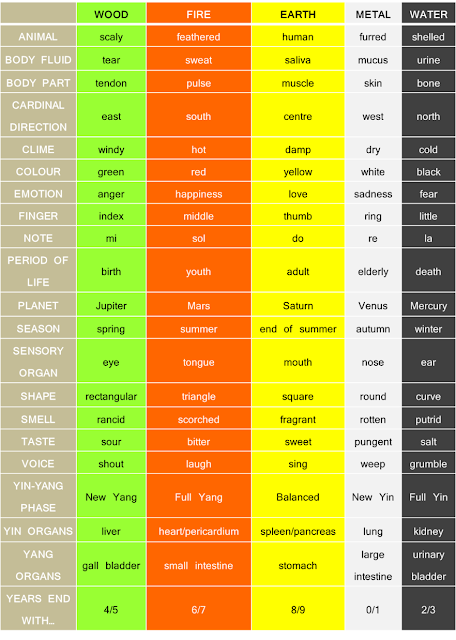
The earliest Taoist practices were inspired by the ways of animals. Shamans drew inspiration from the stars. They saw green dragons, vermillion birds, yellow snakes, white tigers, and black turtles. Eventually these mythical creatures of the heavens were joined by animals walking the earth or flying in the sky. These animal forms were eventually standardized, becoming the Five Animal Frolics.
A previous post called Listening to Trees explores the Five Element and Five Season models commonly used in Traditional Chinese Medicine (TCM). But, where do the Five Animal Frolics fit in? Metal is always the element of winter, fire is the element of summer, water is the element of winter… but the animals? The animals take some twists and turns. Literally and figuratively. Get ready to think outside of the box.
Model #1: Five Elements/Seasons/Organs with the five animals. Reminder: the fifth season is what some call "harvest." Others call it late summer, we used to call it Indian summer.
The inconsistency among these models? Animals. Time to frolic and dance.
Animal Frolics imitate movements of the tiger, the deer, the bear, the monkey, and the bird. Let's look at the bear.
Mimi Duo Deemer in her book Qigong and the Tai Chi Axis describes the bear forms:
"The forms... draw on the power and strength of the bear, but also use twisting and rotational movements that directly stimulate and release tension from the area of the kidneys and adrenal glands."
The forms that she demonstrates release tension in the back, build suppleness in the waist but also strength the legs and arms. We release fear and embrace self confidence, "...make me feel powerful and full of perseverance."
Winter is the season of maximum Yin, time to rest. Winter is when nature lies fallow. Energy is conserved. Plants store resources deep in the earth.
If we as humans were to follow our natural inclinations, we would seek out cozy, warm havens to settle in for the winter.
I join some others relating the bear to the harvest season and those "in between times" that occur before each equinox and solstice. Time to gather our resources and prepare for the upcoming season. The Chinese Health Qigong Association describes the bear as clumsy, heavy and slow. The bear sways, the bear lumbers. Focus is placed on the area of the stomach and spleen, organs of the harvest season and the metal element.
Swaying motions affect the epigastric region, back to the stomach and spleen. During the harvest and fall seasons the bears need to put on weight to prepare for winter and hibernation. This process is called hyperphagia. During hyperphagia bears live for food, don’t get in the way.
We practice movements imitating these qualities of the bear. Movements nurturing the stomach and spleen. Movements rooting us to the earth. But we’ll also nurture the kidneys and the water element by turning and twisting the waist.
And now, the deer.
The deer also conjures images and movements of the winter. Deer spring into action, but then they stand still and alert. Yesterday in Colorado we had a snow storm, action. Today feels quiet and withdrawn, stillness.
But then, there are movements that elongate the gall bladder meridian and strengthen the muscles along the liver meridian.
Gall bladder and liver, organs of the spring and of the wood element.
Mimi Kuo Deemer describes the deer forms as related to the spring.
“… they follow coiling pattern through the spine that suggest the movements in spring, which are to spiral upwards and outwards. The deer represents grace, sexual vitality and spirit.”
Let’s bring it all together:
During the Eastern Han Dynasty (25-250 CE), an esteemed doctor named Hua Tuo formalized movements imitating the instinctual patterns of animals. He called this practice Wu Qin Xi, or Five Animal Frolics.
By moving with intention we learn to trust our inborn animal instincts. We learn and imitate their rhythms and movements as they adapt to the seasonal changes.
The Chinese Health Qigong Association states:
“Wu Qin Xi is not designed just for superficial imitation of the outer attitudes of those animals… the postures and movements of the exercises are elegant, so as to stimulate enthusiasm for learning and practicing the exercises… after a certain period of practice, both physical and mental health are improved.”
Think and move like the tiger, the deer, the bear, the monkey and the bird.
Become these animals.
Resource time!
The 5 Element Theory and the associations of each element. The animals listed on this table are from the 5 Sacred Guardians, yet another set from the old days. These are mythical creatures based on Astrology. That’s for another time.
Videos to practice with:
Be well, be happy, respect your instincts, frolic, and follow your bliss.
💗
Brian










No comments:
Post a Comment